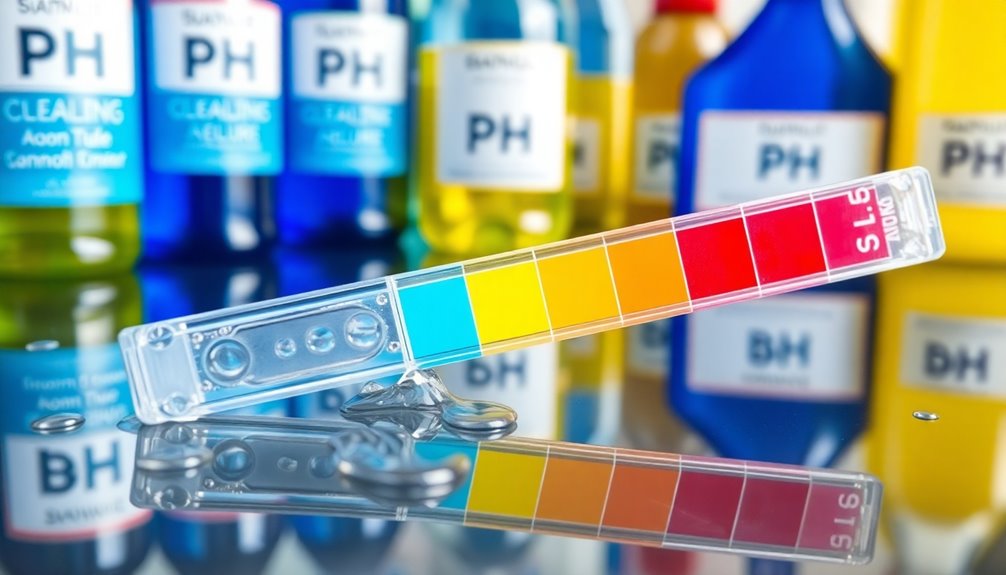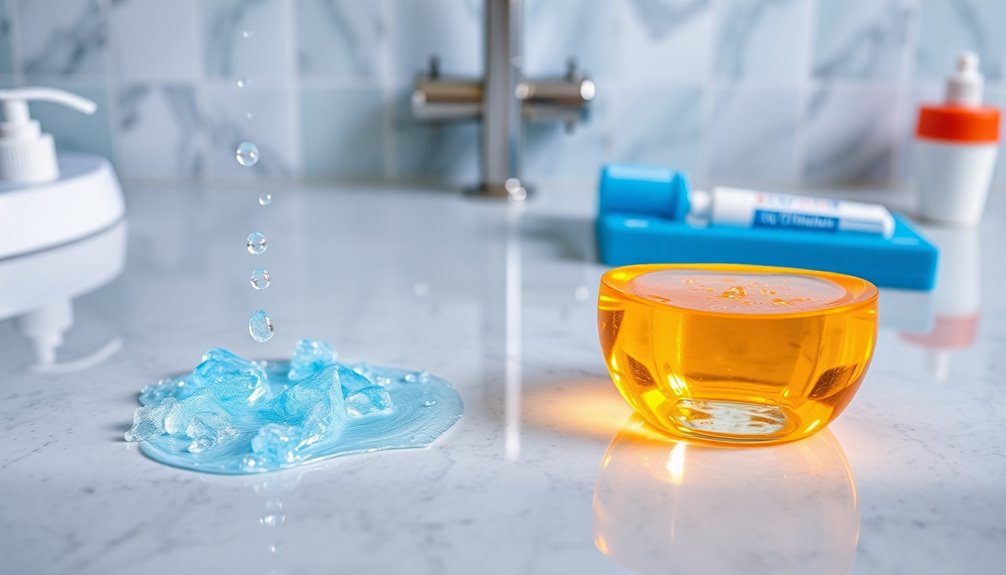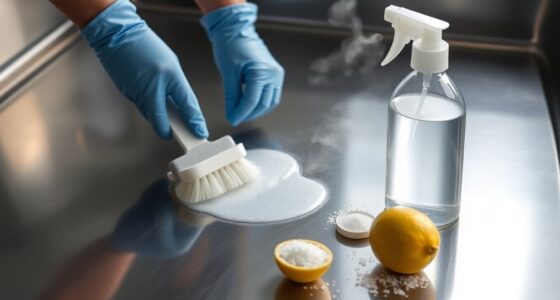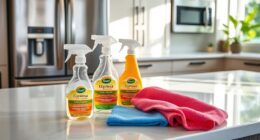Acidic and alkaline cleaners work differently based on their pH levels. Acidic cleaners, with a pH of 0-6, effectively remove mineral deposits like limescale, while alkaline cleaners, ranging from pH 8-14, break down grease and oils. Matching the right cleaner to the stain type is essential for effective cleaning. Always conduct patch tests and avoid mixing cleaners. Knowing the science behind these products helps you make informed choices for better results, and there's more to explore about their specific applications.
Key Takeaways
- Alkaline cleaners, with a pH of 8-14, are effective against grease, oils, and proteins through a process called saponification.
- Acidic cleaners, ranging from pH 0-6.9, excel at removing mineral deposits like limescale and rust by releasing hydrogen ions.
- Matching the cleaner's pH to the stain type ensures maximum effectiveness; use alkaline for organic stains and acidic for mineral stains.
- Conduct patch tests on delicate surfaces before using strong cleaners to prevent damage and ensure compatibility.
- Avoid mixing acidic and alkaline cleaners to prevent harmful gas production and potential health risks.
Understanding Ph Levels in Cleaning Products

When you choose a cleaning product, understanding its pH level is essential for achieving the finest results.
pH levels range from 0 to 14, with 7 being neutral, and this scale directly influences how effective a cleaner will be on various stains and surfaces.
Acidic cleaners, with pH levels between 0 and 6.9, excel at dissolving mineral deposits like limescale and rust.
Acidic cleaners, with pH levels of 0 to 6.9, are highly effective at removing mineral deposits such as limescale and rust.
On the other hand, alkaline cleaners, ranging from 8 to 14, target organic stains such as grease and oils through saponification.
Neutral cleaners, around pH 7, are safe for delicate surfaces, minimizing the risk of damage.
Additionally, understanding the air quality considerations can help you choose the right cleaning products that won't compromise your indoor environment.
The Effectiveness of Acidic Cleaners

Acidic cleaners are highly effective for tackling tough stains and mineral deposits, as they dissolve inorganic materials through chemical reactions. With a pH range of 0-6, these cleaners release hydrogen ions (H+) that interact with negatively charged ions in mineral compounds, facilitating stain removal. Common examples include vinegar and lemon juice, both excellent at removing limescale and rust stains. Stronger acids like hydrochloric and sulfuric acid are often found in toilet cleaners for tough mineral deposits. Acidic solutions preserve surface integrity while effectively breaking down deposits without harsh scrubbing. Additionally, the health benefits of air purifiers emphasize the importance of maintaining a clean air environment while using these cleaning agents.
| Acidic Cleaners | Uses |
|---|---|
| Vinegar | Limescale removal |
| Lemon Juice | Rust stain removal |
| Hydrochloric Acid | Toilet bowl cleaning |
| Citric Acid | Kitchen surface cleaning |
| Sulfuric Acid | Heavy-duty stain removal |
The Power of Alkaline Cleaners

Alkaline cleaners pack a powerful punch against tough organic stains, making them essential in any cleaning arsenal.
With a pH range of 8 to 14, these cleaners effectively break down grease, oils, and proteins through a process called saponification.
Here are four common alkaline cleaning agents you can use:
- Baking soda – Great for deodorizing and scrubbing surfaces.
- Ammonia solutions – Excellent for cutting through tough grime in kitchens.
- Trisodium phosphate (TSP) – Ideal for heavy-duty cleaning tasks.
- Liquid soap – Works wonders for emulsifying oily residues.
In kitchen and bathroom environments, alkaline cleaners excel at tackling food stains and soap scum, making them your go-to option for effective cleaning. Additionally, HEPA filtration can significantly improve indoor air quality by removing airborne pollutants often released during cleaning processes.
Matching Cleaners to Specific Stains

Choosing the right cleaner for specific stains can greatly enhance your cleaning efficiency.
Alkaline cleaners, with their high pH, excel at removing stains caused by grease, oils, and proteins, making them ideal for laundry and kitchen surfaces. These cleaning agents work by emulsifying and dispersing organic substances, ensuring superior cleaning results.
On the other hand, acidic cleaners are your go-to for removing mineral stains like limescale and rust, particularly from hard water deposits. Their low pH facilitates chemical reactions that dissolve these tough residues. Additionally, understanding the different cleaning methods can help you select the most effective solution for your cleaning needs.
Best Practices for Using Ph-Based Cleaners

When using pH-based cleaners, it's crucial to match the cleaner's pH level to the type of stain you're dealing with.
Follow these best practices for maximum effectiveness:
- Identify stain type: Use alkaline cleaners (pH 8-14) for grease and oil, and acidic cleaners (pH 0-6) for mineral deposits like limescale.
- Conduct a patch test: Always test on an inconspicuous area to avoid damaging surfaces or discoloration.
- Follow dilution ratios: Adhere to manufacturer instructions for proper mixing to enhance cleaning performance.
- Avoid mixing cleaners: Never combine acidic and alkaline cleaners to prevent harmful gas production and reduced effectiveness.
For delicate surfaces, opt for a neutral pH cleaner to protect finishes from etching or damage while maintaining effective cleaning practices. Additionally, using advanced filtration systems in your vacuum can help reduce allergens while cleaning.
Frequently Asked Questions
How Do Alkaline Cleaners Work?
Alkaline cleaners work by breaking down organic stains and residues, like fats and oils, effectively.
When you apply these cleaners, their high pH triggers a process called saponification, where they react with the fats to form soap.
This soap emulsifies the oils, making them easier to wash away with water.
To boost their effectiveness, consider factors like temperature, agitation, and contact time while cleaning, and you'll achieve better results.
What Is the Science Behind Cleaning Agents?
Did you know that nearly 80% of household stains can be effectively removed with the right cleaning agent?
The science behind cleaning agents lies in their ability to interact with dirt and grease. Surfactants in these products help lift stains by having both water-attracting and water-repelling ends.
Additionally, the pH level plays a vital role; acidic cleaners target mineral deposits, while alkaline ones tackle organic stains like grease and oils.
How Do Acid Cleaners Work?
Acid cleaners work by dissolving mineral-based stains like limescale and rust. When you apply an acid, its hydrogen ions interact with the negatively charged ions in the minerals, breaking them down.
You might use common acids like vinegar or lemon juice for everyday cleaning, as they're effective yet gentle on surfaces. For tougher stains, stronger acids can help, but always remember to handle them with care to avoid damaging other materials.
What Is the Difference Between Acid Cleaner and Alkaline Cleaner?
The difference between acid and alkaline cleaners lies in their composition and purpose.
Acid cleaners, with a lower pH, tackle mineral deposits and rust stains effectively. You'd use them on surfaces like tiles and toilets.
In contrast, alkaline cleaners, which have a higher pH, excel at breaking down organic stains like grease and oil, making them perfect for kitchens.
Knowing which cleaner to use can save you time and guarantee effective cleaning.
Conclusion
In the world of cleaning, knowing your pH levels can really make or break your efforts. By understanding when to use acidic versus alkaline cleaners, you can tackle stains like a pro. Remember, it's all about matching the right cleaner to the job at hand. So, don't throw in the towel when faced with tough messes; armed with this knowledge, you're ready to shine. Keep it simple, and your cleaning routine will be as smooth as silk!










